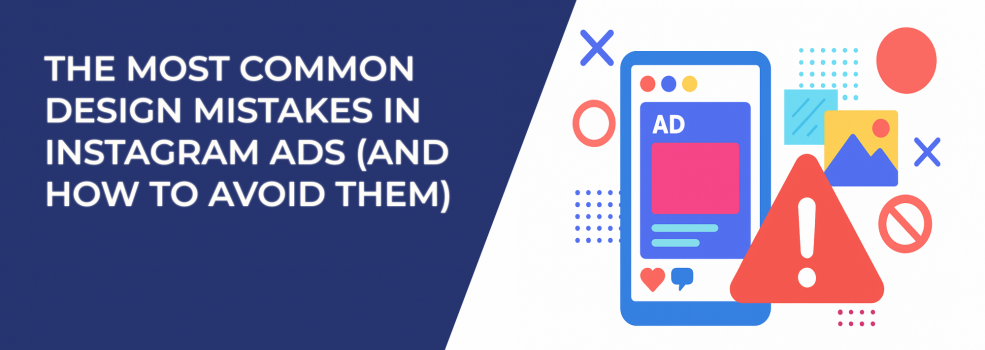Instagram ads are one of the fastest ways to reach your audience — but even the best targeting won’t save a campaign if the design is off. Poorly designed creatives don’t just fail to convert; they can actively damage brand perception.
If you’ve ever wondered why your Instagram ads aren’t performing, chances are at least one of these common design mistakes is to blame. Let’s break them down and cover exactly how to fix each one so your ads not only look good but drive measurable results.
6 design mistakes you're making with Instagram ads and how to avoid them
1. Overcrowding the design
Mistake: Trying to fit every image, offer, and slogan into one ad. Overloaded visuals create confusion, not curiosity.
Why it hurts performance: Instagram is a fast-scroll environment. If users can’t understand the ad in under three seconds, they’ll move on.
How to avoid it:
-
Choose a single, clear focal point (a product shot, person, or bold graphic).
-
Limit supporting elements to no more than two.
-
Use white space strategically so the design feels open, not cramped.
Example:
-
Poorly designed ad: A collage of four product photos, three different fonts, “SALE - LIMITED TIME” in two colors, and a logo that takes up the top third of the frame.
-
Well-designed ad: One high-quality lifestyle shot of the best-selling product with a short “20% off today” text overlay in clean, bold font, and a small, unobtrusive logo in the corner.
Pro tip: A/B test a clean version of your creative against your usual design. You might find a 15–20% lift in click-through rates with a simpler look.
2. Ignoring Instagram’s native visual style
Mistake: Designing ads that look like generic web banners or print flyers.
Why it hurts performance: Instagram users are tuned to spot content that doesn’t fit the platform’s look and feel. If it screams “ad,” it’s easier to ignore.
How to avoid it:
-
Use authentic photography, not overproduced stock images.
-
Match your color palette to your brand but keep it consistent with platform trends.
-
For Stories, go vertical and full-screen; for feed ads, use bright, natural imagery that blends in with organic posts.
Example:
-
Poorly designed ad: A bright red banner with all-caps text “BUY NOW,” stock image of a smiling model, and a flashing discount badge.
-
Well-designed ad: A candid-style photo of a customer using the product in a real setting, with a subtle color filter matching your brand palette, and the offer placed in the caption text instead of plastered over the image.
Final note: Ads that mirror the visual rhythm of organic content tend to blend in more naturally, which can lower ad fatigue and extend the lifespan of your campaign.
To make your ads blend seamlessly with platform trends, check out our tips on How to Use Instagram Reels in Your Marketing Strategy — it’s a great way to adapt creative to formats Instagram users already love.
3. Poor text readability
Mistake: Placing text in low-contrast areas, using tiny fonts, or squeezing copy to the edge of the frame.
Why it hurts performance: If your offer or message isn’t readable instantly, it won’t have an impact — especially on small mobile screens.
How to avoid it:
-
Use large, bold fonts optimized for mobile.
-
Keep text within safe margins to prevent cropping in different placements.
-
Add a subtle overlay behind text to make it pop against busy backgrounds.
Example:
-
Poorly designed ad: White text placed over a bright, busy background with no shadow or overlay, making it hard to read.
-
Well-designed ad: Bold, black text placed in a semi-transparent box over the image’s lower third, ensuring maximum contrast and readability.
Pro tip: Use Instagram’s own ad preview tool to check how your text appears in Stories, Reels, and feed placements before publishing.
For more on designing mobile-friendly ads with clear, readable text, see The Best Practices for Designing Mobile-Friendly Facebook Ads.
4. Skipping vertical formats
Mistake: Repurposing horizontal creatives for vertical placements without resizing.
Why it hurts performance: A horizontal ad wastes valuable screen space and can feel disconnected from the immersive experience users expect.
How to avoid it:
-
Design in 9:16 ratio for Stories and Reels as your default.
-
For feed ads, test both 1:1 square and 4:5 vertical for maximum impact.
-
Use platform-specific templates so each placement looks intentional.
Example:
-
Poorly designed ad: A wide landscape image with black bars at the top and bottom in Stories, making it look recycled.
-
Well-designed ad: A full-bleed vertical image filling the entire screen, with the main product centered and the CTA button in the natural thumb zone.
Performance tip: Meta’s own data shows vertical ads can increase view time by up to 30% compared to horizontal formats.
5. Weak branding presence
Mistake: Adding a tiny, barely visible logo or going all-in with branding that overshadows the creative.
Why it hurts performance: Without clear branding, users may not remember who you are. With overbearing branding, the ad feels pushy.
How to avoid it:
-
Integrate brand colors, typography, or design elements subtly into every ad.
-
Place logos in consistent, unobtrusive positions.
-
Make sure branding feels like part of the design, not an afterthought.
Example:
-
Poorly designed ad: Huge logo centered at the top, covering the product image.
-
Well-designed ad: Logo placed subtly in the bottom corner, with brand colors subtly used in the text overlay and background gradients.
Final note: Consistent, balanced branding builds recognition over time, so even quick scrollers start associating your visuals with your business before they’ve read a single word.
If you want to build brand recognition without overwhelming your creative, you might like our piece on Stand Out and Stay On-Brand with Stunning Facebook Ad Creatives.
6. No clear call to action
Mistake: Running an ad without telling people what to do next.
Why it hurts performance: Even the most engaging creative won’t convert if viewers don’t know the next step.
How to avoid it:
-
Keep CTAs short and direct — “Shop Now,” “Learn More,” or “Get Offer.”
-
Match the CTA to the ad’s goal and landing page content.
-
Use CTA buttons provided by Instagram Ads Manager for better visibility.
Example:
-
Poorly designed ad: Beautiful product photo with no CTA, leaving viewers unsure what’s next.
-
Well-designed ad: Product photo with a visible “Shop Now” button at the bottom and a short, benefit-driven caption encouraging action.
Conversion tip: Ensure the landing page matches the promise of the ad. A disconnect here will tank results faster than any design flaw.
Choosing the right CTA is part of a bigger strategy — our article on Meta Ad Campaign Objectives Explained: How to Choose the Right One can help align your creatives with the right campaign goals.
Final takeaway
Instagram ad design isn’t just about aesthetics — it’s about aligning visuals, copy, and user experience so every impression has the potential to convert.
By avoiding these common mistakes, you can dramatically improve engagement rates, brand recall, and ROI.
Before you launch your next campaign, review this checklist. A few small tweaks today can save thousands in wasted ad spend tomorrow.

